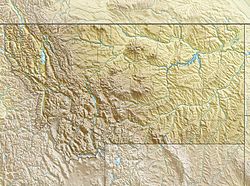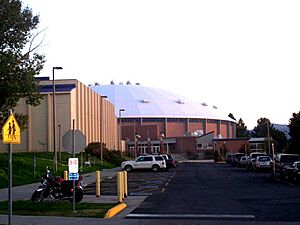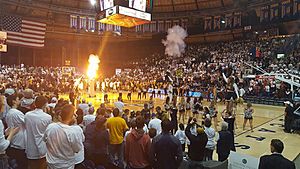Brick Breeden Fieldhouse facts for kids
|
Worthington Arena
The Brick |
|

View from south (c. 2013)
|
|
| Former names | MSU Fieldhouse (1965–81) MSC Fieldhouse (1957–65) |
|---|---|
| Address | One Bobcat Circle |
| Location | Montana State University Bozeman, Montana, U.S. |
| Coordinates | 45°39′48″N 111°03′02″W / 45.6633°N 111.0506°W |
| Elevation | 4,920 feet (1,500 m) AMSL |
| Owner | Montana State University |
| Operator | Montana State Event Services |
| Capacity | 8,455 3,472 (Theatre at The Brick) |
| Construction | |
| Opened | January 11, 1957 |
| Renovated | 1998, 2013 |
| Construction cost | $1.6 million ($17.5 million in 2022 ) |
| Architect | Wilson & Berg |
| Tenants | |
| MSU Bobcats (NCAA) (1957–present) | |
The Brick Breeden Fieldhouse is a large indoor sports and event center. It is located on the campus of Montana State University in Bozeman, Montana. This building is the home for the Montana State Bobcats sports teams.
It is the main place for men's and women's basketball games. It also hosts indoor track and field events. Many other events happen here throughout the year. These include concerts, plays, and trade shows. The fieldhouse also hosts the state high school volleyball tournament. The MSU Spring Rodeo is another popular annual event.
Contents
Discovering the Brick Breeden Fieldhouse
The Brick Breeden Fieldhouse opened in 1957. It was first called the MSC Fieldhouse. The idea for this big building came from architect Oswald "Ozzie" Berg Jr. and university president Roland Renne. They wanted a large indoor space for college sports.
The fieldhouse was once the biggest clear-span wooden building in the world. This means it had a very wide open space inside without support columns. It was later named after John "Brick" Breeden in 1981. He was a longtime basketball coach. The main playing area is called Worthington Arena. It was named in 1985 for Max Worthington. Both men were part of the famous 1929 "Golden Bobcats" basketball team. This team was named national champions.
From 1959 to 1960, the fieldhouse even hosted indoor Little League baseball games. In 1960, the arena became famous for hosting a big boxing match. It was a middleweight title fight between Gene Fullmer and Joey Giardello. This event brought many people to Bozeman and was shown on national television.
Rodeo Events at the Fieldhouse
The Brick Breeden Fieldhouse has a rich history with rodeo. From 1970 to 1996, it was the home of the College National Finals Rodeo. This big event brought college rodeo teams from all over the country.
Today, the arena still hosts the annual MSU Spring Rodeo. This exciting event takes place every April. It showcases the skills of college rodeo athletes.
Modernizing the Arena: Renovations and Upgrades
When the fieldhouse first opened, its main floor was dirt. This was common for many college fieldhouses back then. A special portable court was set up for basketball games. Spectators walked on wooden paths to get to their seats.
Early Upgrades
In 1980, the arena got its first major upgrade. The entire dirt floor was covered with a hard tartan surface. This is a type of polyurethane material. New folding bleachers were also installed. These changes made the arena better for sports.
Major Renovation in 1998
A huge renovation project happened in 1998. It cost $13.2 million. This project completely changed the building. It became a modern, multi-purpose arena.
A new main entrance was built on the south side. This entrance leads people directly to the middle level of the arena. Elevators and other features were added to make the building easy for everyone to use. All the old seats were replaced with new ones.
The building's heating, cooling, and electrical systems were updated. New fire and safety features were also added. The renovation also included new offices for coaches and staff. Locker rooms were improved, and new concession stands were built. A new Hall of Fame was also created. These changes allow the arena to quickly switch from sports events to concerts or theater shows.
See also
- List of NCAA Division I basketball arenas





